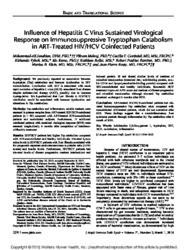Por favor, use este identificador para citar o enlazar este ítem:
http://cris.unibe.edu.do/handle/123456789/69| Título : | Influence of Hepatitis C Virus Sustained Virological Response on Immunosuppressive Tryptophan Catabolism in ART-Treated HIV/HCV Coinfected Patients | Autores: | Jenabian, M. Mehraj, V. Costiniuk, C. Vyboh, K. Kema, I. Rollet, K. Paulino-Ramírez, Robert Klein, M. Routy, J. P. |
Investigadores (UNIBE): | Paulino-Ramírez, Robert | Afiliaciones : | Instituto de Medicina Tropical y Salud Global (IMTSAG) | Área de investigación : | Ciencias de la Salud | Palabras clave: | Indoleamine 2,3-dioxygenase 1; Tryptophan; HIV; HCV; Co-infection; Inflammation | Fecha de publicación : | 2016 | Publicado en: | Journal of Acquired Immune Deficiency Syndromes, 71(3), 254-262 | Revista: | JAIDS : Journal of Acquired Immune Deficiency Syndromes | Volumen : | 71 | Número : | 3 | Página de inicio : | 254 | Página final : | 262 | Resumen : | Background: We previously reported an association between tryptophan (Trp) catabolism and immune dysfunction in HIV monoinfection. Coinfection with HIV is associated with more rapid evolution of hepatitis C virus (HCV)-associated liver disease despite antiretroviral therapy (ART), possibly due to immune dysregulation. We hypothesized that liver fibrosis in HIV/HCV coinfection would be associated with immune dysfunction and alterations in Trp metabolism. Methods: Trp catabolism and inflammatory soluble markers were assessed in plasma samples from ART-treated HIV/HCV-coinfected patients (n = 90) compared with ART-treated HIV-monoinfected patients and noninfected subjects. Furthermore, 17 additional coinfected patients with sustained virological response (SVR) were assessed longitudinally 6 months after completion of interferon-α/ribavirin treatment. Results: HIV/HCV patients had higher Trp catabolism compared with HIV-monoinfected and healthy individuals. Elevated kynurenine levels in HIV/HCV patients with liver fibrosis correlated with the prognostic aspartate aminotransaminase to platelet ratio (APRI scores) and insulin levels. Furthermore, HIV/HCV patients had elevated levels of disease progression markers interleukin-6 and induced protein 10 and shared similar levels of markers of microbial translocation (intestinal fatty acid-binding protein, soluble CD14 and lipopolysaccharide-binding protein) compared with HIV-monoinfected and healthy individuals. Successful HCV treatment improved APRI score and markers of disease progression and microbial translocation although elevated Trp catabolism remained unchanged 6 months after SVR. Conclusion: ART-treated HIV/HCV-coinfected patients had elevated immunosuppressive Trp catabolism when compared with monoinfected HIV-treated patients, which did not normalize after SVR. These findings suggest that a necroinflammatory liver syndrome persists through inflammation by Trp catabolism after 6 month of SVR. |
URI : | https://cris.unibe.edu.do/handle/123456789/69 | DOI : | 10.1097/QAI.0000000000000859 |
| Aparece en las colecciones: | Publicaciones del IMTSAG-UNIBE Publicaciones indexadas en Scopus / Web of Science |
Ficheros en este ítem:
| Fichero | Descripción | Tamaño | Formato | |
|---|---|---|---|---|
| Influence_of_Hepatitis_C_Virus_Sustained.3.pdf | Full text [open access] | 717.46 kB | Adobe PDF |  Visualizar/Abrir |
Los ítems de DSpace están protegidos por copyright, con todos los derechos reservados, a menos que se indique lo contrario.
